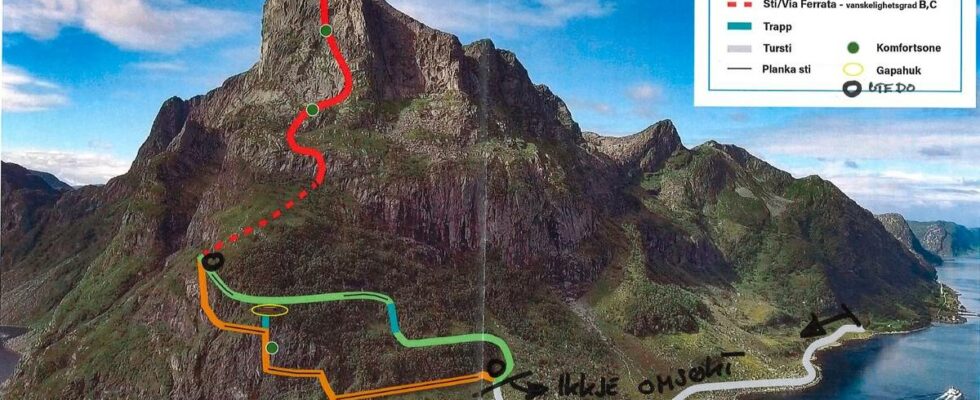The dispute over the climbing route up Hornelen, “Northern Europe’s highest sea cliff”, is intensifying. In July, a municipal decision to close the climbing path to public traffic was canceled by the state because it was not relevant to “restrict the right of the public”. On the night of Monday, the matter took a new turn when a “tired and overwhelmed” tourist was rescued from the climbing trail after being stuck for more than eight hours. It was the second rescue operation in the rock face in a short time. The fronts are as steep as the rock wall after Hornelen was decorated with a climbing route. Photo: Sunnmøre Alpine Rescue Group. – We do well to think about safety first The municipality has made a point several times that the prepared path can lure people up the rock face who have no prerequisites for being there. – This path is the steepest I know of. I think we would do well to think about safety first, says Bremanger Mayor Anne Kristin Førde. In an attempt to avoid new situations with “unnecessary” people on the rock face, the municipality announces a new zoning plan which means that the path can only be used in accordance with an approved climbing guide. – We expect that it will be in order before the new year, says the mayor to Firdaposten. She is supported by the man who led the rescue operation on the night of Monday: – It is the happy madness that anyone who wants to can climb this trail, says the policeman to Fjordenes Tidende. – Allemannsretten is important, but sensible regulation is needed here. On the night of Monday, the matter took a new turn when a “tired and overwhelmed” tourist was rescued from the climbing trail after being stuck for more than eight hours. Photo: Sunnmøre Alpine Redningsgruppe The “holy” Norwegian Common Law Court is considered a Norwegian mark of nobility, and attempts to restrict it automatically cause an uproar among Norwegian outdoor organisations. The Norwegian Climbing Association believes that it must be up to each individual hiker to take responsibility for their own safety – and that a “guardian state” that makes choices on behalf of others does not correspond to Norwegian outdoor traditions. – We have pointed out all along that the via ferrata on Hornelen presents a high risk of dangerous situations and rescue operations both for parties with guides and individuals, because the route is long, goes high into the mountains and is exposed to the weather, says the leader of the association, Stein Tronstad. – But this applies everywhere in steep mountains, and in the mountains we travel freely, with full responsibility for our own safety. From a legal point of view, free movement in the countryside and free access to nature is enshrined in the Open Air Act, and municipalities cannot limit the right of movement due to dangerous terrain. When a ban was introduced against skydiving in Trolltindane (Rauma), a new law was needed, for example, to get permission for this. – The right can be restricted with permission in law, and there are some permissions for this in the Outdoor Activities Act, but in our view they do not allow for the closure of large outdoor facilities like here, says assistant state administrator in Vestland, Gunnar O. Hæreid. NO BIG DEAL: Olav Tryggvason is said to have climbed straight up the rock face with the shield attached to his back. Illustration: Erik Werenskiold Complaint to the ministry The state administrator must look after national interests, and has been on a collision course with Bremanger municipality regarding the iron railway for several years. Hæreigd says that the “main reason” that they tested the municipality this summer is because the area is regulated as a general outdoor area. – If the zoning plan is changed for all or part of the area, it may affect the right of way, he says. Bremanger Eigedom AS and Hornelen Via Ferrata AS have complained about the decision to the State Administrator. This means that the case has been forwarded to the ministry, which will conclude by 10 December. NKF Stein Tronstad, president of Norway’s climbing association. The Court of Common Pleas gives everyone the freedom to take risks at their own level, whether we go mushrooming or climb rock walls. We do not protect “unnecessary” people from their own ignorance on the mountaintops, but trust – with good reason – that most people are able to assess their own safety. This is also the case at Hornelen. The Norwegian Tourist Association Maylinn Stomperud, head of nature management in DNTVi, is pleased that the State Administrator has intervened. This is a unique mountain area and we believe that safety requirements should be taken care of and solved in other ways than closing the public out. We therefore encourage you to look at Via Feratta Loen and other places in the country, where the via feratta routes are open to those who have the skills to use them. news Odd Magne Øgreid, Klatreforbundet We are satisfied with the State Administrator’s decision and would be very surprised if the outcome were different, as the legal text is quite clear on what the municipality can and cannot do. The rationale for lifting the closure is thorough and shows that you cannot simply block off an area with free movement, and turn it into an area where someone should have the exclusive right to run a business. Published 17.09.2024, at 15.54
ttn-69
The municipality and the state in conflict – news Vestland

